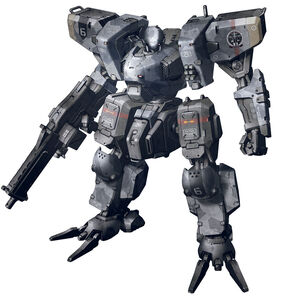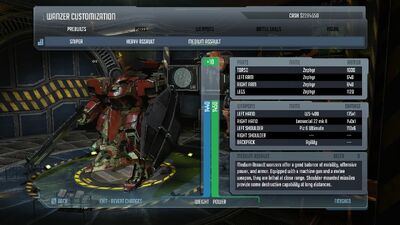In the universe of the Front Mission series, giant mechas called Wanzers (derived from the German word wanderpanzer; wander for "walking", and panzer for "armor") are widely employed for both military and non-military purposes. As a key component of various militaries' combined arms approach, wanzers have been shown to engage in combat alongside tanks, helicopters, fighter jets and other real world weapon platforms. Non-combat wanzer technologies also see use among civilians, such as in civil engineering. Civilian-grade machines are known as wanderwagens, and have a WAW designation. Wanzers, their military counterparts, have a WAP designation.
Overview

The Zenith wanzer
The typical wanzer consists of four parts: a body, two arms, and legs. WAPs, which are about 120% bigger than WAWs, tend to be around 5.5 meters tall and, on average, weigh roughly 25 tons. As wanzer technologies developed, different types of wanzers begin to fill varying combat roles on the battlefield, involved in frontline combat, emergency repair of other weapon platforms, electronic warfare and reconnaissance. The development of WAW and WAP units also leads to derivative technologies, such as armored vehicle-wanzer hybrids known as "Mobile Weapons" (sometimes referred to as "Huge Wanzers"), armored vehicles that possess superior firepower and durability than the standard wanzers. Another derivative of wanzers is the "Advanced Wanzer ". Advanced wanzers are prototype models boasting offensive and defensive capabilities far greater than the average wanzers. They also tend to be 25% to 100% taller than the standard wanzers. Advanced wanzers have been revealed to be standardized with the formation of the MULS-P2 standard; regular wanzers are built on the MULS-P standard.
Although wanzers were initially used as land-based weapons, their uses have expanded to underwater and air support, and as of the 2170s, in space as well. Although it's a versatile weapons platform, wanzers are not strong enough to handle armed forces alone, and they can be surrounded and taken down through guerrilla tactics. Therefore, militaries tend to train wanzer pilots to operate together and work with other weapons platforms. Wanzers are seldom used alone.
Not all soldiers can become wanzer pilots, since piloting a wanzer has been shown to tax both physical and mental strength. In fact, piloting a wanzer seems to be a highly stressful experience for certain individuals, presumably because of the dim and enclosed environment of the cockpit.
However, some other evidence doesn't seem to be quite consistent with this view, since many individuals who apparently do not have that level of strength were also seen to pilot wanzers, with a decent level of efficiency. For example, Lira Labra was also seen engaging in battles in her wanzer during the Alordesh coup d'etat, but her physical build looks nowhere like individuals with more extensive military experience. All in all, it is currently not very clear what level (or types) of physical and mental strength does it take for a person to pilot a wanzer efficiently.
Related Organizations
WAW and WAP production is a booming industry, with many military and non-military organizations involved in the business. There are numerous arms manufacturers who are known to produce wanzer models, such as the Diable Avionics of U.S.N. America and Jade-Metal Lyman of O.C.U. Australia. Wanzer production is known to be a highly competitive field, with new models frequently entering the pool of over a hundred models during the timeline between 2090 to 2112.
Many scientists, including engineers, physicists, and psychologists become involved in the study of these technologies, from researching efficient uses of wanzers in warfare to improving medical technologies such as cybernetic implants and artificial limbs. A notable example is the Durandal of E.C. Britain, an organization dedicated to researching ways to improve the efficiency of wanzers in combat.
It seems that the toy industry has profited from wanzers as well. Children have been shown to possess toy wanzers.
History
For many years, men had labored in research labs to improve machine designs, ultimately attempting to bring them closer to human beings in form. Robotic science was a rapidly-growing field in the late 20th and early 21st centuries, but a consistent problem was their mobility and the fact that they moved in a rather ungainly fashion that did not resemble humans.
However, in the year 2020, the same year as the formation of the United States of the New Continent (U.S.N.), Dr. Landoldt of Wallenstein University and German arms manufacturer Schnecke proposed the model of a new actuator. This was a significant accomplishment, as it enabled the creation of machines that can move in more "human" manner. This proposal immediately drew the interest of the U.S.N. military. Schnecke, Dr. Landoldt and American arms manufacturer Diable Avionics soon joined hands in their research, and in 2025, they completed the first of these machines, called the “wanderwagen” (from the German words wander, "to walk", and wagen, "car or carriage"), abbreviated as WAW.
In the following year, WAW began service in U.S.N. military. However, at this stage, the wanzer technology was still too expensive to have any practical uses in military. In 2029, the M.U.L.S. (Multi-Unit Link System) was created by Schnecke, Diable Avionics, English arms manufacturer Sender, and Australian arms manufacturer Jademetal as a standardized platform for WAW technology to reduce developmental costs. This system represented a worldwide collaboration involving many of the major world powers. In that same year, the first mass-produced WAW, codenamed "Cicada", was completed. The U.S.N. Army purchased 97 of these machines, and the E.C.'s German Army ordered 15 of them.
Meanwhile, political strife in Africa led to the beginning of the African Conflict in 2034. Squadrons of O.C.U. WAWs were deployed to the battlefield in Africa. This was the first time the technology had been used in a combat situation; they proved to be very effective. Research and development began focusing on making WAWs more suitable for military operations.
It took several years, but in 2040, Schnecke and Diable Avionics released a new WAW standard tailored for military applications. Considerably cheaper and more powerful than before, the new MULS-P machines soon became a large part of militaries around the world. To distinguish them from the normal WAWs, those made for military use were dubbed “wanderpanzers” (German for “walking armor”), or “wanzers” for short. Thus, the wanzer as a weapon of war was born.
From this point forward, the wanzer became a standard piece of wartime machinery, appearing often in international skirmishes. When the First Huffman Conflict began in 2070, squads of wanzers were deployed to fight in the battles.
As the wanzer continued to prove its worth on the battlefield, research and development continued at a brisk pace, to further advances in wanzer technology and build better, more powerful models. In the mid-22nd century, a new M.U.L.S. standard was formed to facilitate mass-production of advanced wanzers. Dubbed MULS-P2, this new standardization greatly reduced manufacturing costs and led to a decline in old wanzers as they were deemed inferior to the newer and larger models. Arms manufacturers slowly phased out the usage of old wanzers, relegating them to civilian uses, and began production of the new MULS-P2 compatible wanzers.
In-Game Mechanics

Wanzer Customization in Front Mission Evolved
Wanzers differ from other combat units in that it has four modular parts: body, left arm, right arm, and legs. Each part serves a specific function and has its own stats. Body keeps the wanzer operating. Upon its destruction, the wanzer will lose all battle capacity. Arms are equipped with weapons. If an arm is destroyed, the weapons equipped on it will cease functioning. Legs enable movement and evasion. When legs are destroyed, evasion will be lost, and movement will be severely impaired. A wanzer can continue fighting even if its arms or legs are destroyed, but its performance will be conceivably impaired.
The back of the Body can be equipped with backpacks, which serves various functions such as emergency repair and carrying items. Each arm has two places for equipping weapons: Hand and Shoulder. The hands are generally equipped with guns or melee weapons, while the shoulder are typically for heavy artillery such as missile launchers, grenade launchers, and cannons. However, most of the time players will not be able to fill all four spaces due to the limitation of weight. Other than practical customization, players can also choose the colors of their wanzers. However, this feature is purely aesthetic, except in Front Mission Alternative and Front Mission Online, where the color schemes can serve as camouflage.
Abbreviations
Some installments in the Front Mission series use different designations for wanzers:
- Wander Panzer/Wanzer (WZR, WAP)
- Wander Wagen/Walking Armored Wanzer (WAW)
- Panzer
- Vanzer
Trivia
- Almost all playable characters in the series pilot Wanzers.
- The term "Wanzer" should correctly be pronounced "Vonser".
